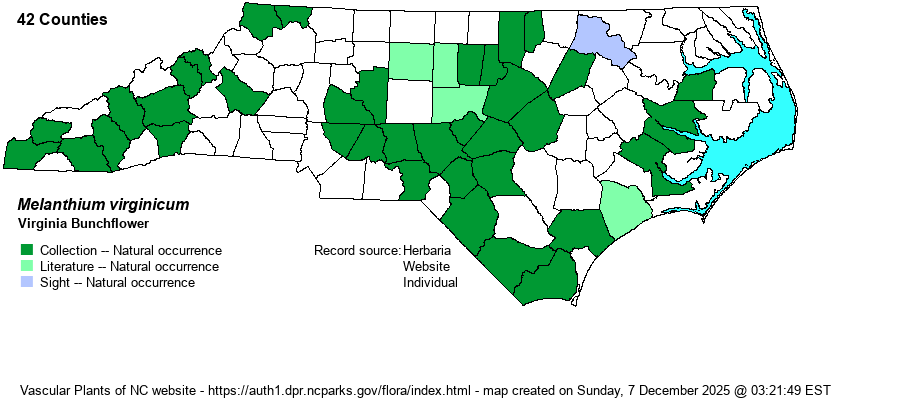| Author | L. | |
| Distribution | Widely scattered over the Mountains, Piedmont, and the Coastal Plain, with large gaps in the latter two provinces. It has been recorded from under 40% of the state's 100 counties, and leaves sizable holes in the range. A review of the BONAP map (for Veratrum virginicum) makes it obvious that such holes are not real ecological gaps in the range.
This is a fairly widespread, though nowhere common, species of the eastern US. It ranges north to southern NY and IA, and south to central FL and eastern TX. | |
| Abundance | Generally rare to uncommon in the Mountains, the eastern Piedmont, and the southwestern Coastal Plain (including the Sandhills). Very rare in most of the western and central Piedmont, and also in most of the central and eastern Coastal Plain. Seems to be most widespread (though scarce and a good find) in the Sandhills and other counties along the Fall Line. Despite it being scarce, it is not nearly as rare as the NC NHP's state rank of S2S3, and this website recommends S3S4, especially as it is considerably more widespread in the state than is M. hybridum (S3 rank). | |
| Habitat | This is a lily that grows in wet places, mostly in forested seepages, streamhead pocosins, damp ground along wooded streams, and floodplain pool margins. It can grow in fairly sunny places such as pine savannas and bogs, but in general it prefers at least partial shade. | |
| Phenology | Blooms from June into August, and fruits from August to October. | |
| Identification | This is one of the taller-growing lily species, and thus is a particularly striking wildflower. It has long, strap-like basal leaves in a clump in wet ground; leaves are up to 2 feet long but only about 1 inch wide at most. The stalk is a broad panicle that often reaches 4-5 feet tall, with the inflorescence at times being 2 feet high from top to bottom. The several dozen flowers are white or slightly greenish-white, with six elliptical tepals, each with a narrowed base (stalk). The spread flower is about 3/4-inch wide. Two other lilies have tall and broad open panicles of dozens of white flowers and basal leaves; however, M. hybridum flowers have wavy, crinkled margins, and Stenanthium gramineum has very small star-like flowers with pointed tepals. It is not often that a biologist runs across Virginia Bunchflower, but when one is seen in bloom, it is a memorable day indeed. | |
| Taxonomic Comments | This species has gone from Melanthium virginicum in RAB (1968) to Veratrum virginicum (as in BONAP) to back to M. virginicum again (as in Weakley 2018).
| |
| Other Common Name(s) | Bog Bunchflower, Bunch-flower [too generic, as several other species are named as bunchflowers] | |
| State Rank | S2S3 [S3S4] | |
| Global Rank | G5 | |
| State Status | | |
| US Status | | |
| USACE-agcp | | |
| USACE-emp | | |

